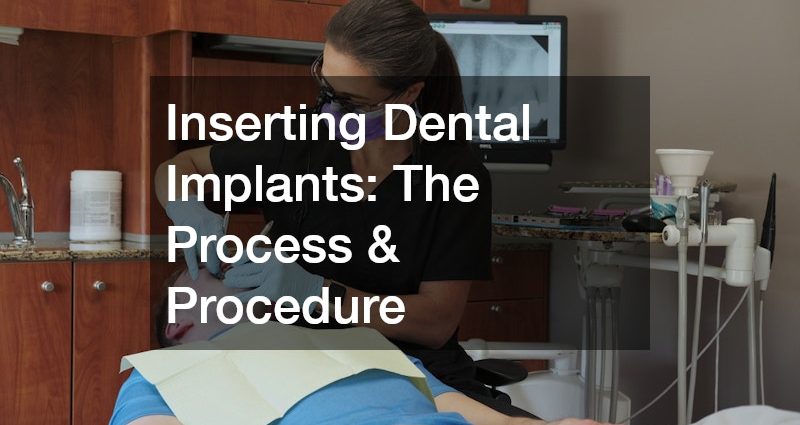
Inserting Dental Implants: The Process & Procedure
Missing teeth can affect more than just your smile—they can impact your ability to eat, speak, and maintain overall oral health. For many people, dental implants have become the preferred solution for replacing lost teeth because they offer a long-lasting and natural-looking result. Unlike traditional dentures or bridges, dental implants are designed to mimic the structure of real teeth, providing both stability and functionality.
This article aims to provide a detailed guide on dental implants, covering everything from what they are and who can benefit from them to the step-by-step procedure, preparation tips, potential risks, and recovery process. Whether you are considering implants for a single tooth or multiple teeth, understanding each stage of the process can help you feel confident and informed about the treatment. By the end, you’ll have a clear picture of what to expect and how dental implants can improve both your oral health and quality of life.
What Are Dental Implants?
Definition of Dental Implants
Dental implants are artificial tooth roots, typically made of titanium, that are surgically placed into the jawbone to support a replacement tooth or bridge. They provide a permanent and natural-looking solution for individuals who have lost one or more teeth.
Components of a Dental Implant
A dental implant generally consists of three main components: the implant post, which acts as the artificial root; the abutment, which connects the post to the replacement tooth; and the dental crown, which mimics the appearance and function of a natural tooth.
Types of Dental Implants
The two most common types of dental implants are endosteal implants, which are placed directly into the jawbone, and subperiosteal implants, which rest on top of the bone but under the gum tissue. The type chosen depends on the patient’s bone structure and specific dental needs.
Benefits of Dental Implants
Dental implants offer numerous advantages, including improved oral function, enhanced appearance, prevention of bone loss, and increased comfort compared to removable dentures. They also provide long-term stability and can last many years with proper care.
Who Can Get Dental Implants?
Ideal candidates for dental implants are individuals with good oral health, sufficient jawbone density, and no untreated gum disease. Non-smokers and those without chronic health issues such as uncontrolled diabetes tend to have the best success rates.
How is the Dental Implant Procedure Performed?
Initial Consultation and Planning
The process begins with a thorough dental examination, including X-rays or 3D imaging. Your dentist will review your oral health, discuss your treatment goals, and design a customized plan to ensure optimal placement and results.
Surgical Placement of the Implant
During the procedure, the dentist surgically inserts the implant post into the jawbone under local anesthesia. This step involves creating a small opening in the bone to anchor the implant securely.
Osseointegration Phase
After placement, the implant undergoes osseointegration, a healing period where the bone fuses with the implant surface. This process typically takes several months and is crucial for long-term stability.
Attaching the Abutment
Once the implant has integrated with the jawbone, an abutment is attached. This small connector serves as the link between the implant post and the dental crown.
Placing the Dental Crown
The final stage involves attaching a custom-made dental crown to the abutment. The crown is designed to match the color and shape of your natural teeth, completing the restoration.
How to Prepare for a Dental Implant Procedure?
Dental Assessment and Imaging
A comprehensive dental exam helps evaluate your oral health and determine the best implant placement. Imaging tests, such as CT scans or X-rays, provide detailed views of your jaw structure.
Evaluating Bone Density
Bone density plays a critical role in implant success. If bone loss has occurred, bone grafting may be recommended to strengthen the implant site.
Pre-Surgical Instructions
Patients are typically advised to avoid eating or drinking for several hours before surgery and to arrange transportation, as sedation may be used during the procedure.
Managing Medical Conditions
Individuals with medical conditions such as diabetes or heart disease should discuss their health history with their dentist to ensure proper management and minimize risks.
What is the Recovery Process Like?
Immediate Post-Surgery Care
After surgery, patients may experience mild swelling or bruising. Applying cold compresses and following prescribed care instructions promotes healing.
Managing Pain and Discomfort
Pain is usually managed with over-the-counter medications or prescriptions provided by the dentist. Discomfort typically subsides within a few days.
Diet and Nutrition
Soft foods are recommended during the initial recovery phase. Avoiding hard or sticky foods helps protect the implant site.
Oral Hygiene Maintenance
Keeping the mouth clean is essential. Brushing gently around the implant and using antibacterial mouthwash can prevent infection.
Follow-Up Appointments
Regular follow-up visits allow the dentist to monitor healing progress and ensure the implant is integrating properly with the bone.
Dental implants offer a reliable and long-term solution for replacing missing teeth. By understanding the procedures, preparation, risks, and recovery involved, individuals can make informed decisions and optimize their outcomes. Whether you’re missing a single tooth or several, dental implants can help restore your confidence and improve overall oral health.


